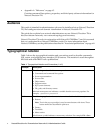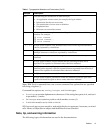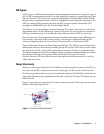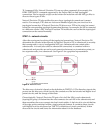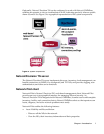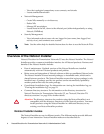Netcool/Precision for Transmission Networks 5.5 Administration Guide4
STEP 1 – discovering the existence of an NE
Deep discovery starts by discovering the existence and, if possible, the type of equipment
available in the network. Users specify a seed IP address/hostname, a subnet mask for the
seed IP, and a set of possible ports to define the boundaries of their network. Users can also
specify protocol-specific parameters, community strings in SNMP, or access parameters for
TL1 devices. The Discovery service then determines the network address, calculates the set
of all possible IP addresses for any machine on that network, and queries the appropriate
addresses. For TL1-managed devices, Netcool/Precision TN sends a RTRV-HDR
command; for SNMP-managed devices, Netcool/Precision TN tries an SNMP get request
on the sysObjectId MIB value.
When the Discovery service receives a response from a device, it tries to identify the type
of device at that address. For TL1-managed devices, Netcool/Precision TN extracts the
target ID (TID) or name of the NE from the RTRV-HDR response. If the NE uses the CLLI
naming convention, the Discovery service can use this information to extract the NEType.
Alternatively, some TL1 devices receive requests on a unique port. This information can be
configured in the NEType file so that the Discovery service can use this to identify the
device. For SNMP NEs, each NEType file has a unique SysObjectId value. The Discovery
service matches the sysObjectId returned by the NE with the value of this variable in the
appropriate NEType to identify the device.
STEP 2 – discovering the contents of an NE
After discovering the existence of an NE, the Discovery service then instructs the Inventory
service to retrieve all the resources in the NE. The NEType determines how this information
is retrieved. For example, for TL1-managed NEs, the Inventory service issues a RTRV-EQPT
command with wildcards to retrieve the rack, shelf, and card information; for
SNMP-managed NEs, it does an SNMP get on the tables in the ENTITY-MIB.
Then, based on the cards that the Inventory service has retrieved, the Facility service looks
for all the physical termination points (PTPs) on these cards, and then for all the logical
resources; that is, the connection termination points (CTPs) for each PTP that is
provisioned.
The Network Connection service locates all the cross-connects configured on each NE.
Netcool/Precision TN discovers not just the existence of the entities, but also their
properties.
STEP 3 – discovering and resolving network topology
Based on the information discovered by the Inventory and Facility services,
Netcool/Precision TN queries the NEs to build a comprehensive topological map of the
network. Devices from the same manufacturer that use similar technology might have
knowledge of the NEs that are physically connected to the device. For example, some ATM
devices, such as the SeaBridge XpressPassTM, support the PNNI protocol. This protocol
enables an NE to communicate with the other NEs it is connected to topologically.
PNNI-aware NEs can thus be queried for the topological connections they are a part of. For



